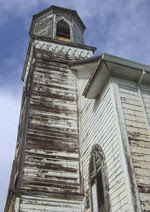Along Deer Creek, about a half mile from its confluence with the Yuba River, a waterfall drops fifteen feet into a cold, clear pool. For salmon migrating up Deer Creek, this pool will be the end of their journey – that clear pool will be as far up the creek as they can travel. A faint, time worn trail leads up from the pool to a hill on the north side of the river, and from there follows Deer Creek upstream through the oaks, and countless bedrock mortars pock the boulder outcrops along the way.
 How sacred this pool must have been to the Maidu who walked that trail between the pool and their village, and who celebrated the Chinook salmon who returned every spring and fall to this very pool but no farther, their numbers stacking up till they packed the pool so tightly it must have been impossible to lower a net without pulling it back up filled with fish. One can almost hear the songs of thanks and praise that must have accompanied the salmon’s return and the feasting that followed.
How sacred this pool must have been to the Maidu who walked that trail between the pool and their village, and who celebrated the Chinook salmon who returned every spring and fall to this very pool but no farther, their numbers stacking up till they packed the pool so tightly it must have been impossible to lower a net without pulling it back up filled with fish. One can almost hear the songs of thanks and praise that must have accompanied the salmon’s return and the feasting that followed.Along the river are relics of a later time, as well, with stacked walls of rock rising twenty feet and more from the water’s edge. Built with great care and enormous effort, these walls must have been the work of the Chinese laborers who toiled at the Black Swan hydraulic diggings.
 Opening into an overgrown swale above the walls is the mouth of the large tunnel through which the dynamited cobble and gravel of the mine was washed, the tunnel in which those Chinese spent their days standing in rushing water, raking cobble and gravel over the cut stone riffles which captured the heavier gold. The stone walls must have supported buildings, now long vanished, in which the gold was separated from the mercury and cementatious gravel in which it was bound.
Opening into an overgrown swale above the walls is the mouth of the large tunnel through which the dynamited cobble and gravel of the mine was washed, the tunnel in which those Chinese spent their days standing in rushing water, raking cobble and gravel over the cut stone riffles which captured the heavier gold. The stone walls must have supported buildings, now long vanished, in which the gold was separated from the mercury and cementatious gravel in which it was bound. A little up from the creek are traces of the old stagecoach road which ran from Parks Bar, through Sucker Flat and Excelsior, then up Deer Creek to Mooney Flat Road, and from there to the diggings at French Corral. Numerous stone foundations, overgrown with oak and buckeye, jut out unexpectedly from the undergrowth and are some of the only traces of the community that once spread across this hillside. And now those miners have followed the Maidu into history, leaving little trace except for bedrock mortars and these stacked stone walls.
A little up from the creek are traces of the old stagecoach road which ran from Parks Bar, through Sucker Flat and Excelsior, then up Deer Creek to Mooney Flat Road, and from there to the diggings at French Corral. Numerous stone foundations, overgrown with oak and buckeye, jut out unexpectedly from the undergrowth and are some of the only traces of the community that once spread across this hillside. And now those miners have followed the Maidu into history, leaving little trace except for bedrock mortars and these stacked stone walls.































